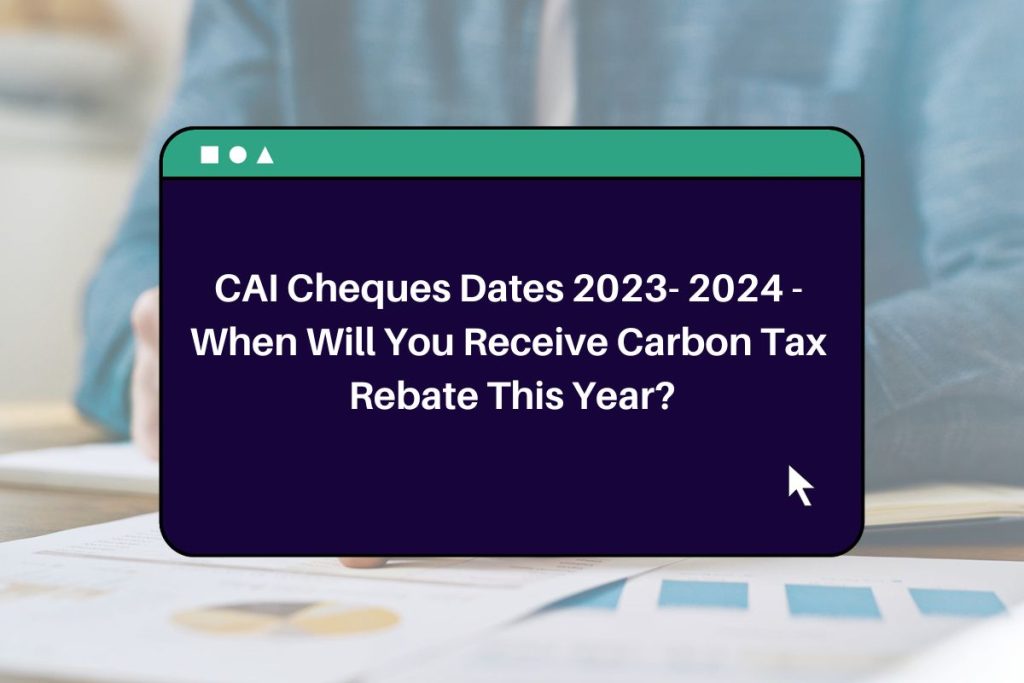One issue that is becoming more and more obvious is climate change and Canadians are more affected by it the more severe it becomes. The Canadian government is aware of this and has responded to counteract it by offering Carbon Tax Rebate. Fighting climate change is challenging not in Canada but in other countries too.
As a result, they have had to adopt additional tax-related measures. However, some of these additional taxes you pay may be refunded to you through your federal tax return, depending on where you live.
Residents of Nova Scotia, Prince Edward Island, and Newfoundland and Labrador have got the quarterly payment tax credits on their taxes in October, as part of the CAIP, it is for citizens of Alberta, Ontario, Manitoba, and Saskatchewan with a tax credit for years. So check this article to know CAI Cheques Dates 2023- 2024, i will update you on When Carbon Tax Rebate is Coming This Year? so you dont miss the CAIP Payment 2023-24.
CAI Cheques Dates 2023- 2024
On October 13, 2023, the Canada Revenue Agency (CRA) distributed the final Climate Action Incentive Payment (CAIP) to taxpayers in Canada. The amount of your Climate Action Incentive (CAI) payments, or carbon tax rebate, is depend upon your residence location in Canada as well as the size of your household.
To find out more about how this federal refund affects you, choose your province from the list below. Finally, we cover the details of the Canadian carbon tax system, the Climate Action Incentive (CAI) payment (including who is eligible for the refund and when it is paid), and the carbon tax’s actual amount.
CAIP/Carbon Tax Rebate 2024 Details
| Name of Organization | Canada Revenue Agency |
| Program Name | Climate Action Incentive Payment (CAIP)/Carbon Tax Rebate |
| Next Payment Date | January 15, 2024 |
| Category | Finance News |
| Rebate Amount | Depends on family’s condition |
| Official Website | Canada.ca |
What is the Climate Action Incentive Payment or CAIP?
In order to partially offset the cost of the federal pollution pricing, residents of Alberta, Manitoba, Ontario, Saskatchewan, and, as of July 1, 2023, Newfoundland and Labrador, Nova Scotia, and Prince Edward Island, will receive a quarterly benefit known as the Climate Action Incentive Payment (CAIP).
Known as the Climate Action Incentive (CAI) until 2021, this benefit was a refundable tax credit that was claimed yearly on personal income tax returns. Another name for this payout is a carbon tax refund. On October 13, residents of Prince Edward Island, Nova Scotia, Newfoundland and Labrador, Ontario, Saskatchewan, Manitoba, and Alberta has received Carbon Tax Rebate payment.

Carbon Tax Rebate- Eligibility
- Currently, residents of Alberta, Manitoba, Saskatchewan, and Ontario are qualified for the federal refund.
- The reimbursement amounts will change based on household size and province over time. In Ontario, for instance, the base amount for a family of four is CAD 745.
- The Canada Revenue Agency (CRA) will ascertain your entitlements after receiving your tax return; you do not need to apply for the CAI payment.
- You can potentially be qualified for an extra 10% base amount supplement if you live in a small or rural community.
- Additionally, universities, schools, towns, charitable organizations, Indigenous communities, and small and medium-sized enterprises will receive a portion of the federal tax revenue.
When Carbon Tax Rebate is Coming This Year?
The Climate Action Incentive Payment 2024 Date is January 15, 2024 and if the 15th falls on a Saturday, Sunday, or federal holiday, the payment is typically issued on the last working day before the 15th. A family of four will get annual payments in 2023–2024 ranging from CAD 976 in Ontario to CAD 1,544 in Alberta.
Beginning in July 2023, residents of Prince Edward Island, Nova Scotia, and Newfoundland and Labrador will receive three quarterly payments. For a family of four, the total payout for nine months will range from CAD 960 for PEI (with a 10% extra) to CAD 1,312 for NL.
How Carbon Taxes Work
The government of Canada was forced to impose carbon pollution fees due to the severity of climate change and the associated costs of rebuilding, including damages from flooding and wildfires. Fossil fuels and products that release carbon dioxide or other emissions are subject to this tax. Its purpose is also to counteract the consumption of things that emit carbon dioxide.
This is known as a carbon tax or carbon pricing, and the amount of the tax varies depending on where in Canada you live. It is noteworthy that the federal government receives no cash from this carbon tax levy.
Climate Action Incentive Payment Amounts
| AB | SK | MB | ON | NB | NS | PEI | NL | |
| First adult | CAD 193 | CAD 170 | CAD 132 | CAD 122 | CAD 92 | CAD 124 | CAD 120 | CAD 164 |
| Second adult | CAD 96.50 | CAD 85 | CAD 66 | CAD 61 | CAD 46 | CAD 62 | CAD 60 | CAD 82 |
| Each eligible child | CAD 48.25 | CAD 42.50 | CAD 33 | CAD 30.50 | CAD 23 | CAD 31 | CAD 30 | CAD 41 |
| Family of four | CAD 386 | CAD 340 | CAD 264 | CAD 244 | CAD 184 | CAD 248 | CAD 240 | CAD 328 |
- About the Author
- My Recent Posts

Why do British Columbia not receive CAI payments?